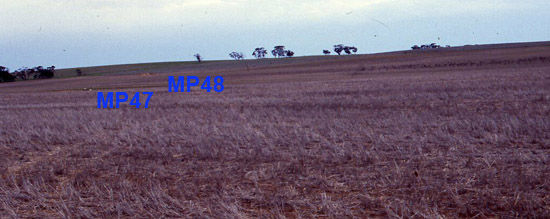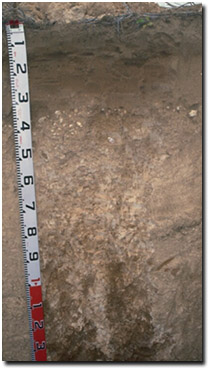MP48
| Location: Murrayville Landcare Group. | Australian Soil Classification: Epibasic, Regolithic, Hypercalcic, CALCAROSOL. |
| Geology: Quaternary (Woorinen Formation) deposits. | General Landscape Description: Lower slope of sandy rise. |
| Site Description: Grazing paddock. |

MP48 Landscape
Soil Profile Morphology:
Surface Soil
| A11 | 0-10 cm | Grey-brown (10YR5/3); loamy sand; weak consistence (moist); non-calcareous; pH 8.2; clear change to: |  MP48 Profile |
| A12 | 10-15 cm | Darkish greyish brown (7.5YR4/4); sandy loam (heavy); weak to firm consistence (moist); moderately calcareous; pH 8.1; clear change to: | |
| A2 | 15-30 cm | Greyish brown (7.5YR5/4); sandy loam (heavy); weak consistence (moist); highly calcareous; pH 8.5; clear change to: | |
| Subsoil | |||
| B21k | 30-55 cm | Light brown (7.5YR7/6); fine sandy clay; weak coarse polyhedral structure; firm to very firm consistence (dry); calcareous nodules (10-30 cm) and fine-earth carbonates common (10-20%); very highly calcareous; many macropores; pH 9.0; gradual change to: | |
| B22k | 55-90 cm | Very light greyish brown (7.5YR8/4); light clay; very firm consistence (dry); very many (50%) fine-earth carbonates; very highly calcareous; pH 9.9; clear and wavy change to: | |
| B23k | 90-130 cm | Brown (7.5YR5/6); light clay; common (20%) fine-earth carbonates; very highly calcareous; pH 10.0: | |
| B3 | 130+ cm | Red (2.5YR5/8) with light grey-brown (10YR7/3) mottles; clay; strong coarse blocky structure; few (5%) soft manganese segregations; moderately calcareous; pH 9.8. | |
Key Profile Features:
- Lack of strong texture contrast between surface (A) horizons and subsoil (B21) horizon.
- Large amounts of mainly soft carbonate (lime) in subsoil.
pH | Salinity Rating | |||
Surface (A1 horizon) | Moderately alkaline | low | - | None |
Subsoil (B21 horizon) | Strongly alkaline | low | Non-sodic | None |
Deeper subsoil (at 1.3 m) | Extremely alkaline | high | Strongly sodic | Strong |

| The soil profile becomes increasingly alkaline with depth. | The level of soluble salts increases with depth. | The soil profile becomes increasingly sodic with depth. | The clay content gradually increases with depth. |
Horizon | Horizon Depth (cm) | pH (water) | pH (CaCl2) | EC 1:5 | NaCl | Total Nitrogen % | Organic Carbon % | Exchangeable Cations | |||
Ca | Mg | K | Na | ||||||||
meq/100g | |||||||||||
A11 | 0-10 | 8.2 | 7.8 | 0.16 | <0.05 | 0.44 | 4.1 | 1.2 | 0.58 | 0.6 | |
A12 | 10-15 | 8.1 | 7.7 | 0.14 | 14 | 1.4 | 0.99 | 0.07 | |||
A2 | 15-30 | 8.5 | 8 | 0.14 | 24 | 2 | 0.97 | 0.07 | |||
B21k | 30-55 | 9 | 8.2 | 0.16 | 24 | 6.7 | 0.5 | 0.43 | |||
B22k | 55-80 | 9.9 | 8.7 | 0.34 | <0.01 | 6.6 | 7.8 | 0.8 | 1.1 | ||
B23 | 80-130 | 10 | 8.7 | 0.52 | <0.01 | ||||||
B3 | 130+ | 9.8 | 8.9 | 0.62 | 0.01 | 2.3 | 4.7 | 0.8 | 4.2 | ||
Horizon | Horizon Depth (cm) | Exchangeable Aluminium mg/kg | Coarse Sand (0.2-2.0 mm) | Fine Sand (0.02-0.2 mm) | Silt (0.002-0.02 mm) | Clay (<0.002 mm) |
A11 | 0-10 | 38 | 54 | 8 | 1 | |
A12 | 10-15 | 34 | 52 | 11 | 1 | |
A2 | 15-30 | 29 | 49 | 12 | 7 | |
B21k | 30-55 | 20 | 32 | 17 | 26 | |
B22k | 55-80 | <5 | 17 | 20 | 22 | 36 |
B23 | 80-130 | |||||
B3 | 130+ | <5 |
Management Considerations
Whole Profile
- In general, management strategies for all soils should aim to: increase organic matter levels in the surface soil, minimise the degradation of soil aggregates and porosity, promote the development of stable biopores, break up any hardpans, and improve the calcium status of the ion exchange complex. Particularly when sodium plays a significant part i.e. the soil is sodic. Less frequent tillage, using less aggressive implements, and working the soil at optimum moisture conditions can all assist in maintaining soil aggregation and porosity, as well as reducing the breakdown of organic matter. Farming practices on cropping soils such as residue retention, minimum tillage and pasture rotations could be utilised to build up organic matter, reduce erosion risk and increase the soils low inherent fertility.
- The soil profile is strongly to extremely alkaline throughout. This suggests that phosphorus and some trace elements such as iron, manganese, zinc and copper may be poorly available to plants and deficiencies may occur.
- Boron toxicity can also occur in strongly alkaline soils.
Profile Described By: Mark Imhof (August 1999).


